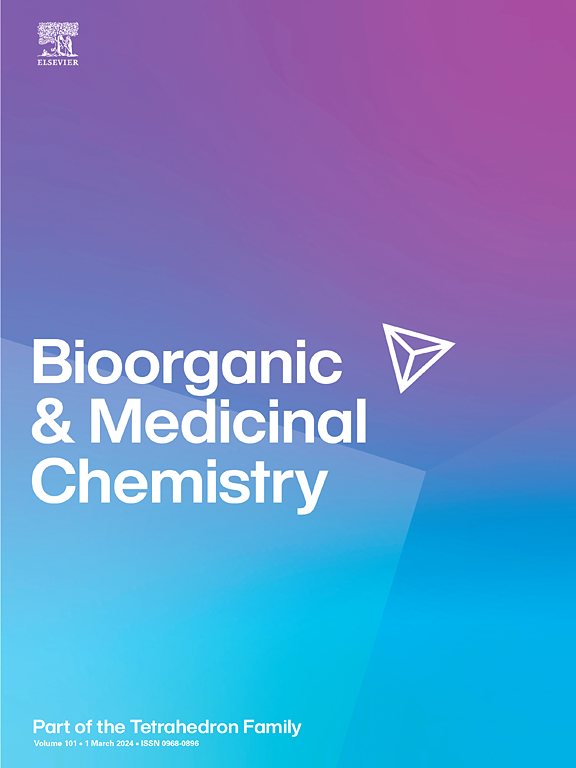Design, synthesis, and evaluation of the pharmacological activity of novel NMDA receptor antagonists based on the germacrone scaffold
IF 3.3
3区 医学
Q2 BIOCHEMISTRY & MOLECULAR BIOLOGY
引用次数: 0
Abstract
The NMDA receptor has long attracted researchers’ attention due to its potential as a drug target and its central role in the central nervous system. The NMDA receptor is a ligand-gated and voltage-dependent ion channel widely distributed in the central nervous system. In this study, we employed a drug design strategy combining “molecular assembly” and “combinatorial chemistry.” By reducing the carbonyl group of germacrone to a hydroxyl group and esterifying it with alanine and linarinic acid, we successfully obtained nine novel germacrone derivatives through two rounds of structural optimization. We evaluated the neuroprotective activity of these nine derivatives using the MTT assay. The results revealed that compound C1 exhibited particularly outstanding activity, achieving a cell protection rate of 29.63 ± 1.56 % at a concentration of 0.05 μM, outperforming the positive control drug, ifenprodil. Further experiments on NMDA-induced Ca2+ influx verified that the action site of compound C1 was the NMDA receptor, and demonstrated its superior antagonistic effect on the NMDA receptor compared to germacrone and ifenprodil. Additionally, molecular docking studies and ADMET property predictions were conducted for compound C1. The results showed that compound C1 tightly bound to the active site of the NMDA receptor and possessed favorable pharmacokinetic properties. In conclusion, compound C1, characterized by a germacrone-linarinic acid structure, not only exhibits strong antagonistic effects on the NMDA receptor but also demonstrates excellent pharmacokinetic properties, indicating its potential for further development as a therapeutic drug for central nervous system diseases.

基于德国酮支架的新型NMDA受体拮抗剂的药理活性的设计、合成和评价。
NMDA受体由于其作为药物靶点的潜力及其在中枢神经系统中的核心作用,长期以来一直吸引着研究人员的关注。NMDA受体是一种广泛分布于中枢神经系统的配体门控和电压依赖性离子通道。在这项研究中,我们采用了一种结合“分子组装”和“组合化学”的药物设计策略。通过将德国宏酮的羰基还原为羟基,并与丙氨酸和亚胺酸酯化,我们通过两轮结构优化,成功得到了9个新的德国宏酮衍生物。我们使用MTT试验评估了这九种衍生物的神经保护活性。结果表明,化合物C1在0.05 μM浓度下的细胞保护率为29.63±1.56%,优于阳性对照药物伊芬普罗地尔。进一步对NMDA诱导的Ca2+内流进行实验,证实化合物C1的作用位点为NMDA受体,并证明其对NMDA受体的拮抗作用优于germacron和ifenprodil。此外,对化合物C1进行了分子对接研究和ADMET性质预测。结果表明,化合物C1与NMDA受体活性位点紧密结合,具有良好的药动学性质。综上所述,化合物C1不仅对NMDA受体具有较强的拮抗作用,而且具有良好的药代动力学特性,具有进一步开发作为中枢神经系统疾病治疗药物的潜力。
本文章由计算机程序翻译,如有差异,请以英文原文为准。
求助全文
约1分钟内获得全文
求助全文
来源期刊

Bioorganic & Medicinal Chemistry
医学-生化与分子生物学
CiteScore
6.80
自引率
2.90%
发文量
413
审稿时长
17 days
期刊介绍:
Bioorganic & Medicinal Chemistry provides an international forum for the publication of full original research papers and critical reviews on molecular interactions in key biological targets such as receptors, channels, enzymes, nucleotides, lipids and saccharides.
The aim of the journal is to promote a better understanding at the molecular level of life processes, and living organisms, as well as the interaction of these with chemical agents. A special feature will be that colour illustrations will be reproduced at no charge to the author, provided that the Editor agrees that colour is essential to the information content of the illustration in question.
 求助内容:
求助内容: 应助结果提醒方式:
应助结果提醒方式:


